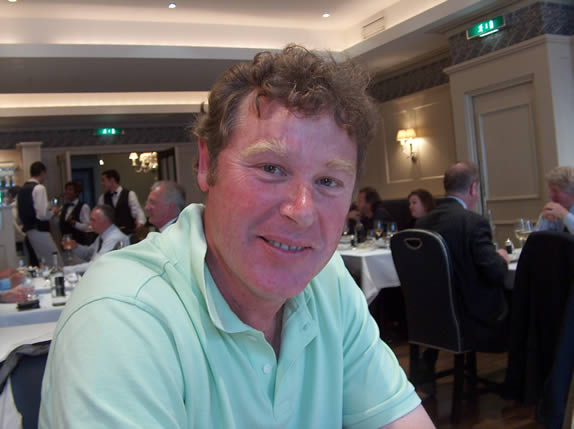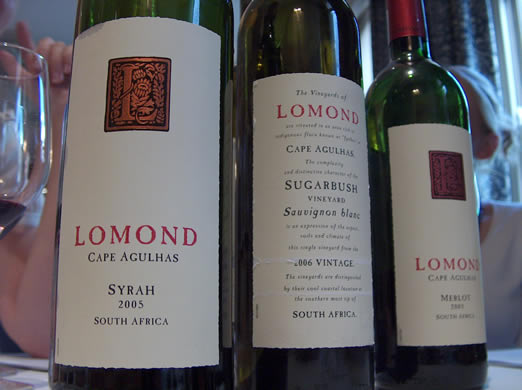|
South
African wine
Lomond,
Cape Agulhas

Wayne Gabb (pictured) is the man behind South African
newcomer Lomond, a joint venture with Distell. I met up with him to
look at his wines and generally engage in a bit of nerdy wine talk.
Wayne's background is in fruit growing. Before Lomond came along, he farmed
apples and pears in Elgin for 16 years, and he comes across as an
immensely practical sort of guy – just what you'd want for
establishing a new vineyard from scratch.
What
are the business arrangements behind Lomond? Lomond Properties owns
the vineyards, and the development of the land and making of the wines
is the responsibility of Lomond Wines, a partnership with Distell that
allows Lomond to tap into a significant bank of expertise, cellar
space and marketing and distribution clout. Let's remember here that Distell
control 70% of the domestic market in South Africa.
Lomond
chose Agulhas, the most southerly point of the Cape, as their
location. It's near Elim, in the southern-most wine producing region in Africa.
Located 8 km from the ocean, the main influence here is maritime
breezes, which typically run from 20 to 40 km/h. It’s the coolest ripening area
in South Africa, with average temperatures of 19.2 °C
during the ripening period.
Lots
of work was done before planting, which started in 1999. The entire
farm is a sizeable 800 hectares, with 100 hectares now planted, and
the potential for this to rise to 440 hectares. Before planting,
profile holes were dug every 50 metres, and soil analysis was carried
out. In tandem with GPS measurements, these data were used to build a
map of the soils throughout the property.
This
survey identified 18 different soil types, which can vary even over
scales as small as 20 metres. No irrigation is usually needed here
because rainfall is good. Prior to planting Wayne used a D9 bulldozer
to deep-plough the vineyards to 1.2 m, which was necessary to break up
the compact layers in the soil.

Wayne
recalls that ostriches were a big problem in establishing the
vineyards. The solution? They were shot at 150 m, and made into
biltong. A further difficulty was water. While the vines don’t need irrigation once
they've established themselves, it’s needed to get them going.
In order to get planning permission to plant, Gabb made a deal with
the local authorities. First he agreed to construct a huge lake, that
runs for 3.5 km and occupies 108 hectares. This is larger than the
farm needs, and agreement was entered into with the local municipality
to allow them annual rights to 2 million cubic litres of water. A full
environmental impact study was carried out, showing that the dam and
lake have enhanced the local wildlife rather than destroy it. [See hLomond's
entry in the Biodiversity of Wine Initiative.]
BEE―black ecomonic empowerment―is an issue at the forefront
of South African consciousness, and Lomond have done their bit,
purchasing the property next door, a 79 hectare farm called Uylenkraal,
for this purpose. Farm workers have a 58% share in this venture, which
currently has 12 hectares of vines. It is managed as a trust.
Overall,
seven varieties are planted at Lomond. The most significant are
Shiraz, Merlot and Sauvignon Blanc, with a bit of Viognier, Nouvelle
(a white variety that’s a crossing of Semillon and Crouchen Blanc, grown for its strong
grassy aromas), Semillon and Mourvedre. So far the range consists of
single vineyard wines (Sauvignon Blanc and Shiraz) as well as an
Estate series of varietal wines. Initial signs are very promising
indeed.
First,
two single-vineyard Sauvignon Blanc wines have been made from
adjoining 3 hectare blocks with different soil types in each: the
Pincushion and Sugarbush. Consistent differences have carried through
the first two vintages, even though viticultural and winemaking
practices are exactly the same.
Lomond Sugarbush Vineyard Sauvignon Blanc
2006 Cape Agulhas
Classy,
crisp, minerally, subtly grassy nose. The palate is precise with a
crisp gooseberry character. Lots of concentration, with an almost
spicy minerality. Deliciously fresh and expressive. The clone
Nietvoorbij Weerstasie SB11, known for its grassy, asparagus flavours.
Lomond Pincushion Sauvignon Blanc 2006
Cape Agulhas
Again, there’s a fresh, bright, grassy nose, but with
a bit more fruitiness. The palate is broader, but still fresh and
bright. French clone SB 159 is used here, which yields flavours of fig
and tropical fruits.
Lomond Merlot 2005 Cape Agulhas
A whole
range of clones and practices were employed to make this wine. It has
smooth red fruits on the nose, which is a bit spicy and chocolatey.
The palate has some structure and is very elegant with a bit of
spiciness. Really lovely: one of the best South African Merlots I’ve had. Very good/excellent
91/100
Lomond Syrah 2005 Cape Agulhas
Soft, smooth
and sweetly fruited, with some chocolatey richness. Very stylish and
smooth with lovely concentration and smooth tannins. Soft but dense. A
lovely elegant modern-styled red wine, with attractive peppery
freshness to the fruit. Very good/excellent 93/100
Wines
tasted 09/06
See
also: South
African wine series
Back to top
|

